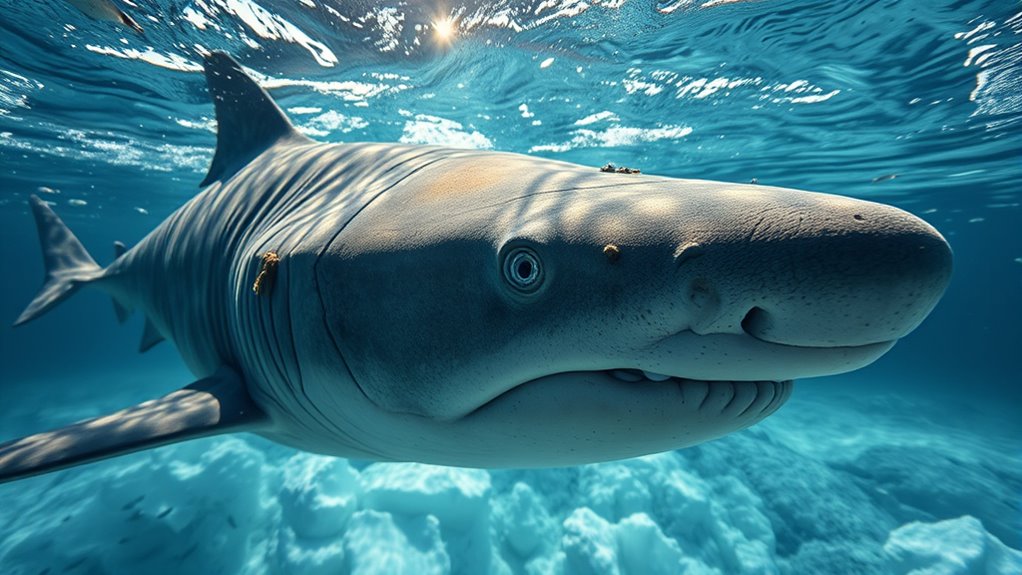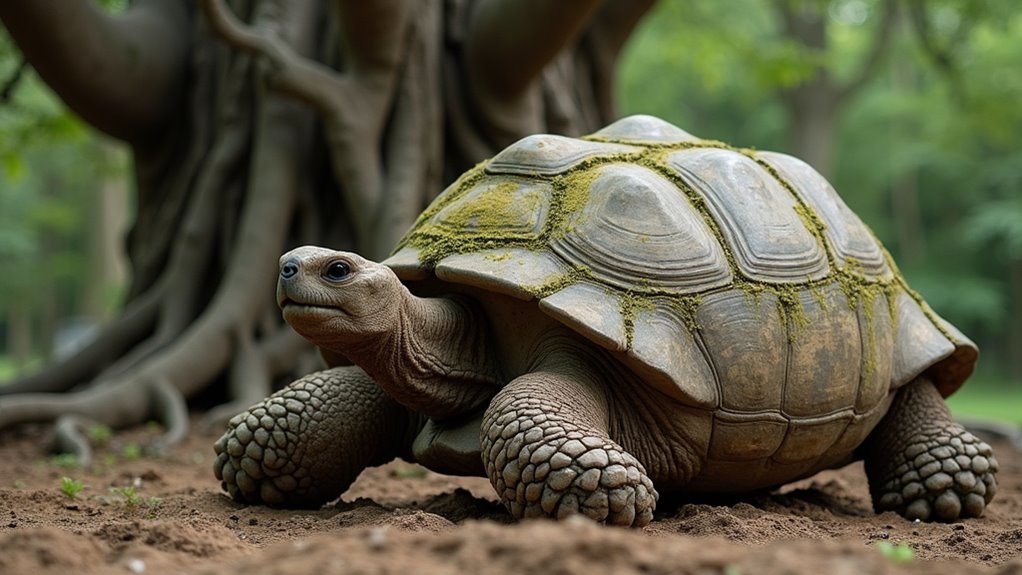Many of Earth’s oldest animals, like the ocean quahog clam and Greenland shark, live over 400 years thanks to unique genetic traits and stable deep-sea environments. Their slow growth, efficient DNA repair, and resistance to aging reveal powerful secrets about longevity. By studying these remarkable creatures, scientists uncover how resilience and adaptation can extend life spans considerably. If you keep exploring, you’ll discover even more fascinating insights into how these animals defy aging.
Key Takeaways
- Some marine animals, like the ocean quahog and Greenland shark, live over 400-500 years due to genetic resilience and cold, stable environments.
- Longevity in animals often results from environmental stability, slow growth, and genetic adaptations that promote cellular repair and disease resistance.
- Invertebrates such as the ocean quahog clam demonstrate extraordinary lifespans, surpassing 500 years, linked to their protected deep ocean habitats.
- Studying long-lived species reveals biological strategies like efficient DNA repair and stress resistance that contribute to slow aging.
- Evolutionary adaptations and environmental factors enable certain animals to maintain health and functionality, extending their lifespans beyond typical limits.

Have you ever wondered which animals have endured the longest on Earth? The answer lies in their remarkable ability to survive through centuries, sometimes even millennia. These creatures have mastered the art of longevity, often thanks to unique biological traits like marine longevity and genetic resilience. Marine animals, in particular, showcase extraordinary lifespans that challenge our understanding of aging and survival. For example, certain species of whales can live over 200 years, silently traversing oceans while maintaining their health and vitality. Their impressive lifespan is partly due to their marine environment, which provides a stable habitat that reduces stressors and predators. More importantly, their genetic resilience plays a fundamental role in their extended longevity, enabling them to repair cellular damage and ward off diseases that typically shorten the lives of other animals.
You might be surprised to learn that some of the oldest animals on Earth are not mammals but invertebrates, especially those inhabiting the deep ocean. The ocean’s depths shield these creatures from many environmental changes, allowing them to age slowly and steadily. For instance, the ocean quahog clam, *Arctica islandica*, can live for over 500 years. Its longevity is a testament to the power of genetic resilience, which helps it resist the typical wear and tear from aging. Scientists have studied these clams to understand the genetic factors behind their durability, and their findings could someday help improve human health and longevity. The secret lies in their ability to maintain cellular integrity over centuries, avoiding the damage that usually accumulates with age.
Another fascinating example is the Greenland shark, which can live for over 400 years. Its slow growth rate and cold, stable environment likely contribute to its longevity. The Greenland shark’s genetic makeup appears to support efficient DNA repair mechanisms, which keep it healthy well into old age. These animals’ longevity demonstrates how evolutionary adaptations and environmental factors, combined with genetic resilience, allow some species to defy the typical lifespan limits most creatures face. Their survival strategies reveal that longevity isn’t just about living longer but about maintaining health and functionality over time.
Frequently Asked Questions
How Do These Animals Avoid Aging or Disease?
You might wonder how some animals avoid aging or disease. They often have genetic longevity, meaning their genes promote slow aging and resistance. Additionally, they excel at cellular repair, fixing damage before it accumulates. These traits help maintain their health and longevity. By understanding these mechanisms, you can learn how their bodies stay resilient over time, revealing secrets that could someday improve human health and lifespan.
Can Scientists Clone or Replicate These Long-Lived Creatures?
Imagine copying a masterpiece; scientists use cloning techniques and genetic engineering to replicate long-lived creatures. They’ve successfully cloned animals like sheep and oxen, but cloning ancient animals remains challenging. While some scientists explore these methods to understand aging, replicating creatures like the Greenland shark is complex due to their unique genetics. Still, ongoing research aims to uncover these secrets, potentially extending human lifespan someday.
What Threats Do These Animals Face From Environmental Changes?
You face threats like climate change and habitat loss that endanger long-lived animals. Rising temperatures disrupt their ecosystems, making it harder to find food and suitable living spaces. Deforestation and human development further shrink their habitats, forcing these creatures into smaller, less stable environments. If you want to protect them, addressing climate change and conserving their habitats are essential steps to guarantee their survival for generations to come.
Are There Any Mythical or Legendary Animals Considered Extremely Long-Lived?
You might think mythical creatures are just stories, but they often symbolize legendary longevity. Creatures like the turtle of immortality or the dragon, revered through ages, embody extraordinary lifespan myths. These mythical creatures, rooted in legends, represent timeless wisdom and endurance. Their stories fuel our imagination, showing that in folklore, some beings are believed to live for centuries or even millennia, making them symbols of eternal life and ancient power.
How Do Their Lifespans Compare to Other Species in Their Habitats?
You wonder how mythical or legendary animals’ lifespans compare to real species in their habitats. These creatures often have extraordinary aging mechanisms and genetic resilience, allowing them to live much longer than typical animals. While real animals show aging signs, mythical beings are believed to defy these limits, highlighting the fascinating contrast. This comparison reveals how biology and imagination shape our understanding of longevity across different worlds.
Conclusion
As you discover these ancient creatures, you realize there’s more to their secrets than meets the eye. What if their longevity holds clues to our own future? Could understanding their resilience unseal the key to lasting life? The answers might be hidden deep within these timeless beings, waiting for you to uncover. Remember, in their silent endurance, lies a mystery that could change everything you thought you knew about survival and longevity.










